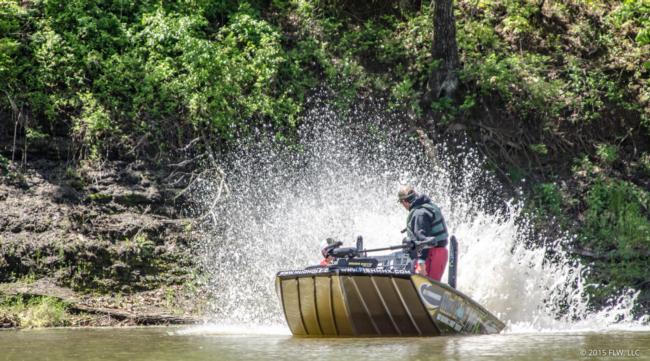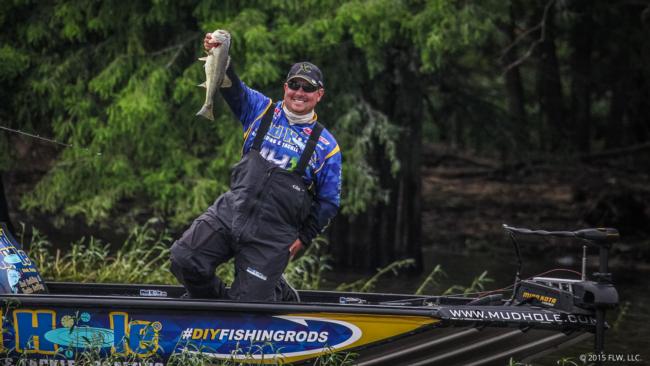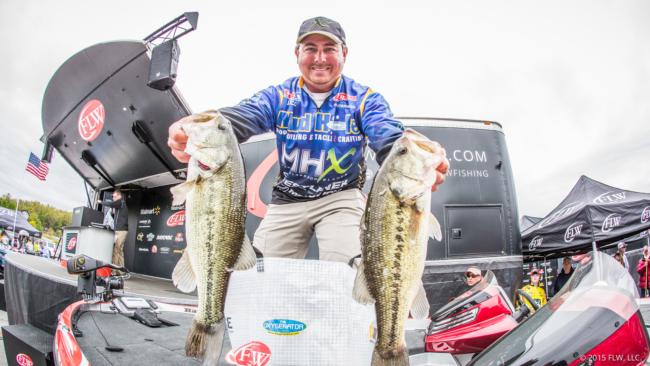No Patterns, No Transducers
10 lessons in shallow fishing with John Cox

In his fifth season on the Walmart FLW Tour, John Cox nearly won the 2015 Angler of the Year award while fishing from a 19-foot aluminum bass boat with no depth finder transducer. He fished only shallow – more or less – made four top 20s and came up 14 points shy of Scott Martin’s winning AOY point total.
The fact that Cox took such an unconventional approach by modern tournament-fishing standards is noteworthy in itself, but how and why he did it goes a little deeper than simply dedicating himself to “fishing his strengths,” as pros so often quip. For Cox, success was the result of a new approach to practice, an innate ability to adapt on the fly and some important lessons learned during competition.
We boiled down the most important factors into 10 key lessons that can help any angler who wants to become a better competitive angler.
Oh, and spoiler alert: He will be using a transducer next season.
1. No Pattern Necessary
Cox’ practice strategy this season was to not get locked in on a pattern. Rather, he sought to scout as much of the lake as possible so that he was prepared for any conditions he might face in the tournament.
“I ended up fishing a lot of places [in the tournaments] where I didn’t catch a fish or didn’t fish at all in practice,” he says. “I’d just look at it in practice and know I could catch fish there.
“Everything changes so much in a week, especially when we get there and the pressure gets on,” he adds. “Sometimes I’d see a couple docks, but I’d look at them while it was raining in practice and think that maybe when the sun comes out I could fish them in the tournament. Or I’d see some grass in practice when there were bright blue skies, but when there was rain or clouds in the tournament I’d go fish it because fishing bank grass is usually a morning thing or for low-light conditions.”
He says that getting locked in on a pattern in practice has hurt him in the past because it’s so hard to abandon that pattern in the tournament when it dries up.
“The whole year I pretty much said I was going to do whatever it takes just to catch them and get paid,” Cox adds.
2. Avoid the Pressure
In addition to looking for fishy waters, Cox also looked for areas that weren’t being pounded by other anglers.
“Moving around, looking at every inch of water on the lake let me see where the boats weren’t fishing,” Cox says. “That’s where I tried to fish.”
Sometimes that meant scouting water that, in practice, was practically unfishable. Cox found one such hole at Beaver Lake so far up the White River that FLW’s media team considered borrowing a kayak in order to cover him.
“I ran up there during practice and didn’t get any bites, but it was really, really muddy,” Cox says. “I didn’t think anyone had gotten bit up there in practice. The first two days I fished mid-lake and made the cut, and I figured by then it had cleared out [upriver]. I ran up there [on day three], and sure enough it was clear. The fish were fresh because no one had fished there.”
He caught 12 pounds, 3 ounces that day and made the top-10 cut.
3. Not Like Thrift, Like Cox
In describing his 2015 season, Cox compared some of his strategies to those of Bryan Thrift, who was neck-and-neck with Cox in the AOY race going into the finale on the Potomac River.
Cox admires Thrift’s ability to perform both deep and shallow, but he says he’s not wired the same way as Thrift. He can’t pull up to 100 precise targets in a day, make a few casts at each and leave.
Instead, Cox prefers to identify stretches of bank, beds of grass, lily pad fields, pockets and the like and then fish every bit of it that looks good if the conditions suggest that he should. The method still covers a lot of water, but it doesn’t require him to be as dialed in on a pattern or series of waypoints.
4. When To Return
Cox says he didn’t re-fish water too often. He usually had only two or three such spots at each tournament. They were places where he’d caught them in the past or where he had a very strong inkling that he could catch them, but he wasn’t sure what conditions he needed.
Example: Lake Eufaula.
“There were some [lily] pads by the ramp where I had no bites in practice or the first day of the tournament,” Cox recalls. “I was constantly hitting them over and over. I’d pull in and spend 20 minutes, and if it wasn’t right I’d leave. I caught them there the second day. It got right because the bluegills showed up. I ended up shaking some off. If they weren’t over 3 pounds I’d pull it away from them. It was perfect that day. Then I went back the third day, and they weren’t in there anymore.”
5. Moving Out
Without a depth finder, Cox had to expand his game the old-fashioned way by simply fishing out away from the bank.
“A lot of areas I found were on the bank, but you had to work the bait, whether a crankbait or ChatterBait or Hard Head [swing jig], by throwing it off the bank a little bit,” he explains. “A lot of that stuff was on points right where everybody would drive by throwing at the bank, and their boats were on the fish. If I went down the bank and caught one or two and knew some fish were there, I’d run over it again. If I didn’t catch any more, I would pull out on the closest place that I thought they might go and might catch one or two.”
6. Moving Baits
Cox saved his finesse tactics for occasionally casting to specific targets, but primarily as follow-ups for when bass wouldn’t eat his moving baits. Usually, something like a Yamamoto Senko was his preferred finesse bait.
On the more aggressive side, he caught a lot of fish on a ChatterBait, but also a swim jig, which he fished anywhere from right on the surface to in the middle of the water column to bumping bottom.
He rarely had a front deck full of different baits, but he did carry plenty of options.
“I usually had 10 rods on the deck, but they’d all be rigged with a little different color or weight,” he explains. “I might have had three ChatterBaits or four jigs, with different line or different lengths and actions of rods for whatever I was going to do and how I was going to work that bait.”
Cox also always had something to flip – a craw, Brush Hog or beaver-style bait usually – rigged with several sizes of weights.
“A lot of the fish that I caught I saw this year,” he says. “Except Chick and Potomac, I probably saw 80 percent of the fish when either they’d come up and take the bait, or they were up cruising.
“If I flipped in with, say, a 3/8-ounce weight and saw the grass kick [from a fish reacting] and nothing happened, I’d go with a heavier weight so it would fall faster and I’d get them to react. Sometimes it was the exact opposite. They might not pick it up, or might pick up for a split second and drop it. Then I’d go with a lighter weight. And if that worked I’d just roll with it from there.”
7. Topwater Tactics
Topwater was also huge for Cox, and he fished some interesting rigs.
The list includes hollow frogs fished in the typical manner, weightless Senkos rigged Texas style and twitched on the surface, soft jerkbaits fished like the Senko, a Zoom Speed Worm rigged with a light weight and buzzed on the surface, and some others.
“When the conditions got right, it seemed like I caught a lot of my bigger fish on topwater,” he says. “That’s how I got most of my key bites, besides one big one I caught on Beaver the third day. That was on a ChatterBait. All my fish on Toho came on topwater – the Speed Worm.”
8. Bluegill-Eating Bass
Bass location and activity are almost always linked to their food, with the possible exception of the spawn. Cox theorizes that his bigger bites resulted from a particular bait species.
“I really don’t know, but I feel like I was mostly targeting fish eating bluegills,” he says. “It just seemed like those were better fish consistently. Usually the fish that roam around eating bluegills are a little bit bigger; at least, I think they are.”
9. Listen to Instinct
Essentially, on the Potomac Cox was one 3-pounder away from winning the AOY title. He caught plenty of keepers, but poorly timed the tides a bit and also found himself stuck sharing water with other pros.
Excuses aside, he really blames one moment of mental complacency for the slip-up – one moment all season when he ignored the instincts that had carried him clear through to that point.
“There was one bar I pulled up on where I always caught fish when the tide was down a little,” he says. “I was casting a ChatterBait and kept getting hung up and couldn’t pull it through nice and smooth. For a split second my brain said, ‘Pull out the swim jig,’ and I didn’t. For some reason I didn’t pick it up and made three or four more throws with the ChatterBait. Then out of the corner of my eye I saw a swim jig go whizzing out there. My co-angler had thrown it, and I already knew what was going to happen. As soon as it hit the water he caught like a 3 1/2. That one mistake cost me the whole thing.”
10. The Big Lesson
Cox’ 2015 season shows that it’s not necessary to rely so heavily on modern maps and sonar technology.
However, one of the most interesting things he learned is that there are almost always limitations when fishing only in shallow water – or, in general, in limiting himself to one program.
“There’s no regret in not having it [a transducer],” he says. “Fishing without it taught me a lot of stuff I needed to know to get better. It kind of helped me get more dialed in on fishing shallow. But it also opened my eyes to when you can’t catch them shallow through the day.”
He says that out of every eight-hour tournament day, he went approximately four to six hours without getting a bite. Sometimes an entire morning or afternoon was cold. Other times lulls set in between bites.
“It [fishing only shallow] helped me learn to see when those bites changed and see when that stuff was going to happen. You could almost time it,” Cox says.
Excluding the Potomac, when Cox caught about 30 keepers a day, his average keeper count was about 10 per day. It wasn’t fast and furious. The lulls in between meant that Cox spent a lot of time in “survival mode,” just catching what he could and then making up for it the next day.
That’s what he did on the first day at Eufaula, when bluebird skies made the deep bite strong, but hurt his grass bite. He survived by cranking “fish attractors” that were placed in the lake by the DNR and marked with buoys – “the stupidest thing ever,” he says. At Chickamauga, Cox found a lot of fish shallow in practice, but they weren’t there in the tournament. He ended up finishing 12th by milking an 8-foot-deep bar that he’d fished in previous tournaments. A top-20 finish typically doesn’t reek of “survival” mode, but it was.
In 2016, Cox plans to add a transducer to his boat so that when the window is closed on the shallow bite he has another option.
“When I knew I was wasting my time up shallow this year, next year that’s when I’m going to fish my deep stuff,” he says. “A lot of the places we went [this season] I didn’t have any deep stuff.”
Of course, there are plenty of important lessons to be learned out deep too.
“In the past, I was catching deep fish but didn’t understand how to change. I’d catch them on a crankbait, but then they’d stop biting, and so many times they’d still be there and I couldn’t get them to bite,” Cox recalls. “I need to learn how to get those fish to bite. I’m excited because I think once I get better at that I can mix both the shallow bite and deep bite and actually seal the deal, like Thrift does. He wins one every year because he can do both so well.”


